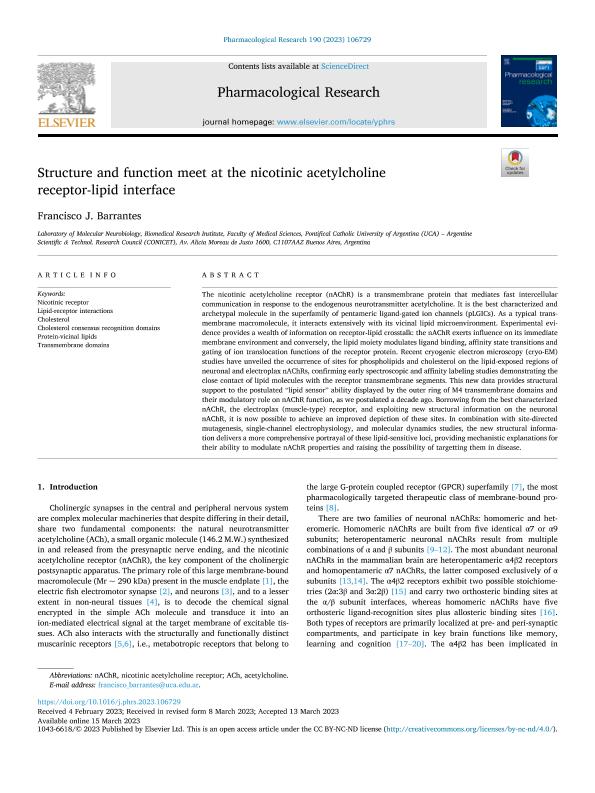Mostrar el registro sencillo del ítem
dc.contributor.author
Barrantes, Francisco Jose

dc.date.available
2024-02-20T15:18:34Z
dc.date.issued
2023-04
dc.identifier.citation
Barrantes, Francisco Jose; Structure and function meet at the nicotinic acetylcholine receptor-lipid interface; Academic Press Ltd - Elsevier Science Ltd; Pharmacological Research; 190; 106729; 4-2023; 1-13
dc.identifier.issn
1043-6618
dc.identifier.uri
http://hdl.handle.net/11336/227656
dc.description.abstract
The nicotinic acetylcholine receptor (nAChR) is a transmembrane protein that mediates fast intercellular communication in response to the endogenous neurotransmitter acetylcholine. It is the best characterized and archetypal molecule in the superfamily of pentameric ligand-gated ion channels (pLGICs). As a typical transmembrane macromolecule, it interacts extensively with its vicinal lipid microenvironment. Experimental evidence provides a wealth of information on receptor-lipid crosstalk: the nAChR exerts influence on its immediate membrane environment and conversely, the lipid moiety modulates ligand binding, affinity state transitions and gating of ion translocation functions of the receptor protein. Recent cryogenic electron microscopy (cryo-EM) studies have unveiled the occurrence of sites for phospholipids and cholesterol on the lipid-exposed regions of neuronal and electroplax nAChRs, confirming early spectroscopic and affinity labeling studies demonstrating the close contact of lipid molecules with the receptor transmembrane segments. This new data provides structural support to the postulated “lipid sensor” ability displayed by the outer ring of M4 transmembrane domains and their modulatory role on nAChR function, as we postulated a decade ago. Borrowing from the best characterized nAChR, the electroplax (muscle-type) receptor, and exploiting new structural information on the neuronal nAChR, it is now possible to achieve an improved depiction of these sites. In combination with site-directed mutagenesis, single-channel electrophysiology, and molecular dynamics studies, the new structural information delivers a more comprehensive portrayal of these lipid-sensitive loci, providing mechanistic explanations for their ability to modulate nAChR properties and raising the possibility of targetting them in disease.
dc.format
application/pdf
dc.language.iso
eng
dc.publisher
Academic Press Ltd - Elsevier Science Ltd

dc.rights
info:eu-repo/semantics/openAccess
dc.rights.uri
https://creativecommons.org/licenses/by-nc-nd/2.5/ar/
dc.subject
CHOLESTEROL
dc.subject
CHOLESTEROL CONSENSUS RECOGNITION DOMAINS
dc.subject
LIPID-RECEPTOR INTERACTIONS
dc.subject
NICOTINIC RECEPTOR
dc.subject
PROTEIN-VICINAL LIPIDS
dc.subject
TRANSMEMBRANE DOMAINS
dc.subject.classification
Neurociencias

dc.subject.classification
Medicina Básica

dc.subject.classification
CIENCIAS MÉDICAS Y DE LA SALUD

dc.title
Structure and function meet at the nicotinic acetylcholine receptor-lipid interface
dc.type
info:eu-repo/semantics/article
dc.type
info:ar-repo/semantics/artículo
dc.type
info:eu-repo/semantics/publishedVersion
dc.date.updated
2024-02-20T13:18:10Z
dc.journal.volume
190
dc.journal.number
106729
dc.journal.pagination
1-13
dc.journal.pais
Estados Unidos

dc.description.fil
Fil: Barrantes, Francisco Jose. Pontificia Universidad Católica Argentina "Santa María de los Buenos Aires"; Argentina. Consejo Nacional de Investigaciones Científicas y Técnicas; Argentina
dc.journal.title
Pharmacological Research

dc.relation.alternativeid
info:eu-repo/semantics/altIdentifier/doi/http://dx.doi.org/10.1016/j.phrs.2023.106729
dc.relation.alternativeid
info:eu-repo/semantics/altIdentifier/url/https://www.sciencedirect.com/science/article/pii/S1043661823000853
Archivos asociados
